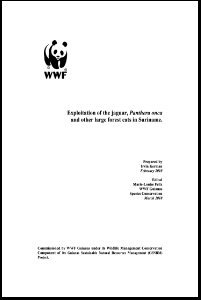By Irvin Kerman
The Guiana’s ecosystems provide habitats to over 4,500 species of flowering plants, 660 species of birds, 300 species of freshwater fishes, 180 species of mammals, 150 species of reptiles and 90 species of amphibians. Of great significance in the Guianas is the large number of wild fauna and flora that are unique to the region. Amongst these are species that are globally in decline but have found safe refuge in the Guianas’ wilderness and are flourishing. Other species are simply endemic to the region, being found in very few other areas of the planet. Amongst the very special species found in the Guianas is the jaguar, Panthera onca, the largest cat of South America. As with species like the giant river otter, Pteronura brasiliensis, the arapaima, Arapaima gigas, black caiman Melanosuchus niger, and giant anteater, Myrmecophaga tridactyla, the jaguar requires an extensive territory to survive and has found this in the Guianas. The extremely low population of humans, most of whom live along the coast, make the Guianas very attractive for forest cats whose migratory behaviour necessitates their having extensive wilderness areas as habitats. Another character that has helped make the Guianas attractive to forest cats has been the general respect and or fear that persons of the region have always had for the species. The jaguar, and many of its smaller relatives such as the jaguarundi, Herpailurus yagouaroundi, ocelot, Leopardus pardalis and the oncilla, Leopardus tigrinus, have rarely ever had to face the threat of targeted exploitation. Human – wildlife conflicts have, in the past, been limited to accidental encounters within the territory of the animals. However, from recent reports to WWF, this situation is feared to have changed. Several species of wildlife are exported annually from Suriname and Guyana to the US, Europe and Japan. Some of these species, particularly birds and wild plants, are also the subject of domestic trade. Globally, illegal and/or excessive trade remains a very significant impediment to the survival of many species. Both Guyana and Suriname have a legal international trade, with export quotas being set per species, based on population estimates and relative abundances worldwide. The quotas also reflect the listing of the species under international conventions. However, the jaguar does not belong to this list of species approved for exploitation. The jaguar is classified by all countries of the Guianas as being endangered and thus in need of protection. This means that it is illegal to target and hunt the species, whether for export, recreation, the domestic pet trade, or for bushmeat. There are only a few exceptions where special provisions are made for capture and shipment for education, exhibition and research to zoological parks, museums and wildlife reserves.
Guianas: WWF Guianas, 2010. 14p.


